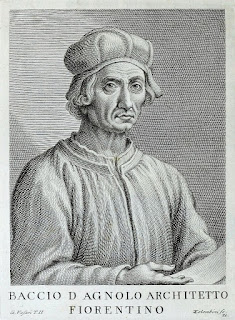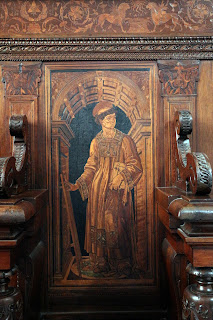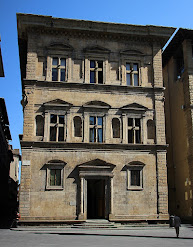Florentine who influenced the look of his home city
 |
| Baccio d'Agnolo was a significant influence on Florentine architecture |
His birth name was Bartolomeo Baglioni but he came to be referred to as d’Agnolo in a reference to the name of his father, Angelo, while Baccio was a popular short form for Bartolomeo. His father was also a woodcarver, which explains the direction of his early career.
Between 1491 and 1502, Baccio executed much of the decorative carving in the church of Santa Maria Novella and the Palazzo Vecchio in Florence before turning to architecture.
He worked alongside Simone del Pollaiolo in restoring the Palazzo Vecchio, and in 1506 was commissioned to complete the drum of the cupola of the Cathedral of Santa Maria del Fiore, although the project was ultimately abandoned after criticism from Michelangelo.
Among the notable buildings attributed to Baccio d’Agnolo are the Palazzo Borgherini-Rosselli del Turco and the Palazzo Bartolini Salimbeni, while his design for the campanile of the church of Santo Spirito has also been praised.
Baccio had five children, three of whom - Giuliano, Filippo and Domenico - also became architects.
It was through studying the best work of contemporaries such as Bernardo della Cecca, Giuliano da Maiano and Francione that he acquired such a high level of skill in working with wood.
 |
| An example of Baccio d'Agnolo's early work with wood carving |
Many of Baccio’s original wood works were lost. The best remaining evidence of his carpentry is the choir of the church of Santa Maria Novella and the 16th-century choir of the church of Sant'Agostino in Perugia, on which his sons are said to have collaborated.
In a second period of his life, Baccio dedicated himself almost exclusively to architecture. He collaborated with Del Pollaiolo and Antonio da Sangallo the Elder on the construction of the Great Hall in the Palazzo della Signoria.
He established himself as an architect in his own right in 1503-04, building the Palazzo Taddei in Via dei Ginori, which was influenced by Del Pollaiolo’s Palazzo Guadagni and became a template for the typical noble Florentine residence of the first half of the 16th century.
His commission to build an eighth part of the gallery around the huge dome of Santa Maria del Fiore, left unfinished by Filippo Brunelleschi, was continued due to the harsh criticism of Michelangelo, who defined it as a "cricket cage".
The Palazzo Bartolini Salimbeni palace in the Piazza di Santa Trinita (1517-20) is considered by some to be Baccio's masterpiece, bringing together all the qualities of his art, the windows surmounted by the pediment and interposed by niches and excavations having a genuine originality.
Executed in the High Renaissance style that Baccio admired during a period in which he worked in Rome, it became a model for civil constructions of the 16th century.
Baccio d’Agnolo died in Florence in 1543, at the age of 80.
 |
| The Palazzo Bartolini Salimbeni is one of Baccio's notable works |
The Palazzo Bartolini Salimbeni is in Piazza di Santa Trinita on Via de' Tornabuoni in central Florence. It was built on the site of a former residence of the Soldanieri and Dati families, which was bought by Bartolomeo Bartolini-Salimbeni, who paid Baccio d'Agnolo two florins per month for his work. The Bartolini-Salimbeni family lived in the palace until the early 19th century, after which, in 1839, it became the Hotel du Nord, where figures such as the American writer Herman Melville stayed. The palace was restored in 1961 and it is now a private property. It once housed the San Romano Battle paintings by Paolo Uccello, which were commissioned by a member of the Bartolini Salimbeni family. The paintings are now distributed between the Uffizi, the National Gallery in London and the Louvre in Paris.
 |
| Palazzo Vecchio, which Baccio helped restore |
Florence’s imposing Palazzo Vecchio, formerly Palazzo della Signoria, a cubical building of four storeys made of solid rusticated stonework, crowned with projecting crenellated battlements and a clock tower rising to 94m (308ft), became home of Duke Cosimo I de' Medici moved his official seat from the Medici palazzo in via Larga in May 1540. When Cosimo later removed to Palazzo Pitti, he officially renamed his former palace the Palazzo Vecchio, the "Old Palace", although the adjacent town square, the Piazza della Signoria, still bears the original name. Cosimo commissioned the painter and architect Giorgio Vasari to build an above-ground walkway, the Vasari corridor, from the Palazzo Vecchio, through the Uffizi, over the Ponte Vecchio to the Palazzo Pitti. Cosimo I also moved the seat of government to the Uffizi, which translated literally, simply means ‘offices’. Today, of course, the Uffizi, is known the world over for its collection of art treasures.
Also on this day:
1860: The birth of politician Vittorio Orlando
1870: The birth of sculptor Pompeo Coppini
1946: The birth of actor Michele Placido
1979: The birth of footballer Andrea Pirlo
No comments:
Post a Comment